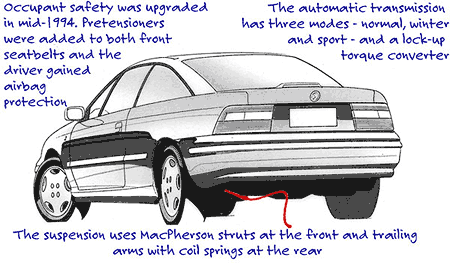BY MALCOLM LIVERMORE | 25th Jul 2003

Opel, General Motors' German arm, managed to combine sleek, flowing styling with an aerodynamically slippery shape which at the time was claimed to be the world's most efficient.
The bonus was enough rear seat space to make the Calibra a genuine four-seater. Add a good sized luggage space with split fold rear seats and the Calibra is a practical, smart and good looking two-door coupe.
The wind-cheating ability had some practical advantages. Fuel consumption is lowered and there is less wind noise.
The Calibra was sold with a single equipment level but with two different power trains for the Australian market.
The manual transmission version has a 2.0-litre, 16-valve, 110kW engine and was targeted at enthusiast drivers. The automatic is teamed up to a less powerful eight-valve engine which was aimed at buyers looking for style and convenience, with less interest in sporty performance.
The Calibra was strong on luxury equipment and the list includes a metal sunroof, central locking, remotely adjustable mirrors and power windows with auto up and down for the driver.
The package also included alloy wheels, a six-speaker radio/cassette and air-conditioning. A neat touch is the roof- mounted aerial with a built-in washer jet for the rear wiper.
The driver and front passenger seats are comfortable with sports- style bolsters which provide good side support. One glaring omission from the driver's point of view is the lack of steering wheel height adjustment, although the seat and seatbelt anchor both have height adjustment.
A safety upgrade in June, 1994, included new spoke-style alloy wheels and new interior trim.
The 2.0-litre automatic version of the Calibra remained on the market unchanged until it was discontinued in 1995, leaving only manual transmission-equipped versions on the market for a further three years.
Under the sheet metal, the Calibra loses some points to its rivals.
The 2.0-litre engine with the auto is a relatively old-fashioned design, closely related to the Holden Camira from the 1980s with a single overhead camshaft and two valves per cylinder.
The result is a very ordinary power output of 85kW at 5200rpm but this is compensated in part by a strong low and mid-range torque figure which suits the four-speed automatic transmission.
The suspension is designed to suit European roads and autobahns so the Calibra is at home on smooth surfaces and is very stable at speed.
The firm ride means it is not so happy on some of Australia's rougher roads.
Overall, the Calibra has stood up to the local conditions reasonably well.
Look out for sun damage to the dashboard cover. It will develop unsightly splits if the car has been parked outside.